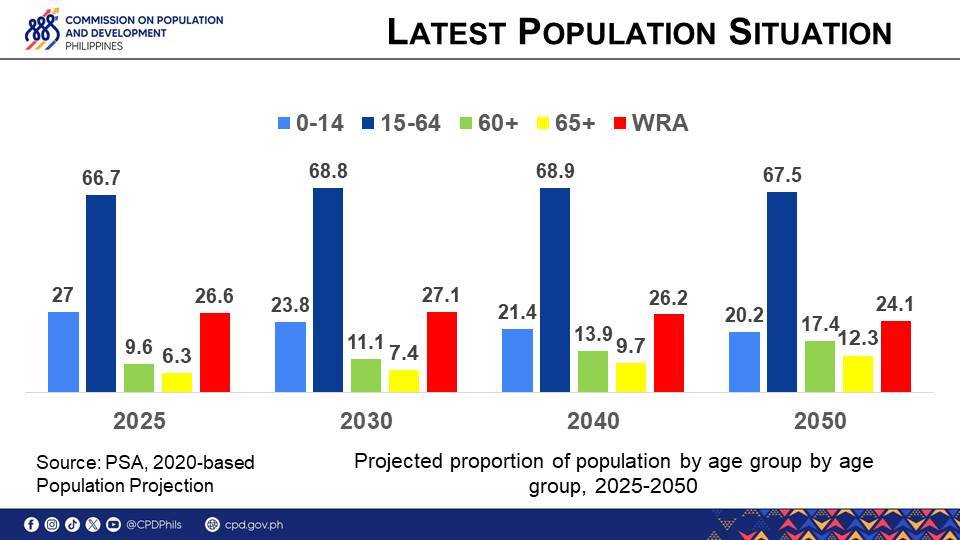Trend sees PH becoming an ‘aging population’ by 2030

The Philippines is poised to have a citizenry of mostly working age individuals and elderly persons in the coming years as a result of the “significant” decline in the country’s population growth rate, the Commission on Population and Development (CPD) said on Thursday.
Speaking to reporters on the sidelines of the 10th National Population, Health and Education conference, CPD Deputy Executive Director Lolito Tacardon noted that the increasing number of working age individuals poses both an opportunity and a challenge to the government.
“If the government would be able to optimize them, they can positively contribute to economic development. But if the government fails to provide them with the necessary jobs or economic opportunities, then they will rely on the resources of the government,” Tacardon said.
Urban migration
He admitted, however, that an aging population would pose more of a challenge given how the government is “still in the process of implementing, for example, universal health care.”
Another concern is that many young individuals remain unemployed, with Tacardon noting that “one of the problems is that job opportunities do not match the education that they have, and they are not prepared yet.”
“What we’re asking for is human capital development but at the same time, it should be coupled with economic intervention, which is creating more jobs, creating more economic opportunities,” he said. “This can’t be addressed by one agency. All of them need to work together.”
Based on the 2024 census by the Philippine Statistics Authority (PSA), the country’s population grew by 0.8 percent yearly from 2020 to 2024, much lower than the 1.6-percent annual increase recorded from 2015 to 2020.
The PSA projected that as early as 2030, some 7 percent of Filipinos will be 65 years old and above. At such percentage, the country would be crossing the threshold and be classified as an “aging population.”
During the 2020 census, the PSA noted that people 65 years and over accounted for 5.4 percent of the total population.
By 2050, Tacardon said the trend may reach its “peak,” with about 12 percent of Filipinos aged 65 years and older.
“The most significant factor related to fertility decline is the improvement of the socioeconomic condition of women in the Philippines,” he explained, citing findings from a survey by the Philippine Institute for Development Studies.
“As they improve their education, their income, there’s a tendency for them to prefer a smaller number of children and delay their fertility, and that’s happening among young people,” Tacardon said. “Because they want to pursue their personal goals.”
Tacardon also pointed out that 16 out of the 18 regions in the Philippines experienc
ed a decline in population growth rate, with the Bicol region posting a negative population growth.
Global trend
Such decline, he noted, was caused by people migrating from rural areas to highly urbanized cities.
“Based on our initial analysis, we found that it’s really being driven by internal migration,” Tacardon said. “Our population movement is shifting now. In the past, people preferred long-distance migration. Nowadays, it’s shorter-distance migration that they prefer.”
He said Region V (Bicol) is an out-migration area, and the recipient of the population is the Calabarzon (Cavite, Laguna, Batangas, Rizal and Quezon) area.
This kind of migration leads to a disproportionate increase in the population of urban areas, with four out of 10 Filipinos living in the National Capital Region, Calabarzon and Central Luzon, according to the PSA.
“We can see that our urban areas are really vulnerable because of the lack of efficient mechanisms to ensure that its carrying capacity is really responsive in promoting the quality of life of Filipinos,” Tacardon noted.
According to the World Health Organization (WHO), people worldwide are living longer and “every country in the world is experiencing growth in both the size and the proportion of older persons in the population.”
By 2030, it said that one in six people in the world will be aged 60 years or over and the share of the population aged 60 years and over will increase from a billion in 2020 to 1.4 billion.
It added that by 2050, the world’s population of people aged 60 years and older will double to 2.1 billion and the number of persons aged 80 years or older is expected to triple between 2020 and 2050 to reach 426 million.
“While this shift in distribution of a country’s population towards older ages—known as population aging—started in high-income countries (for example in Japan 30 percent of the population is already over 60 years old), it is now low- and middle-income countries that are experiencing the greatest change. By 2050, two-thirds of the world’s population over 60 years will live in low- and middle-income countries,” the agency said.

















